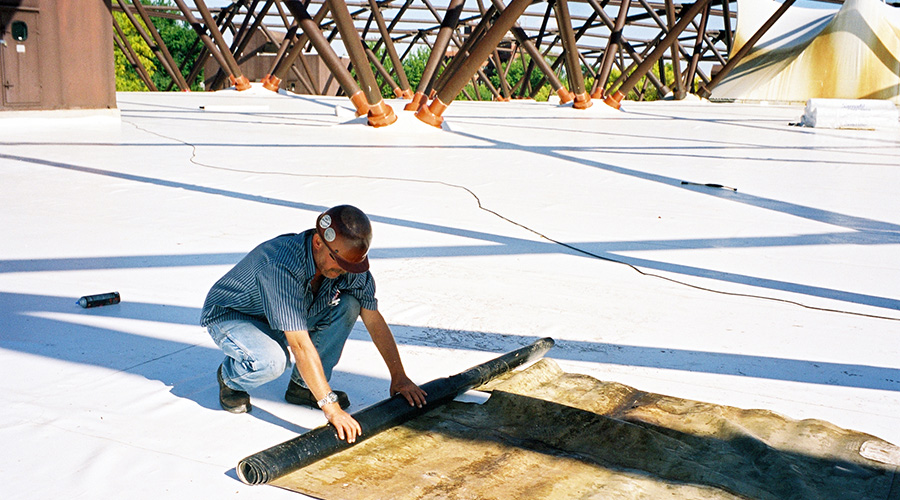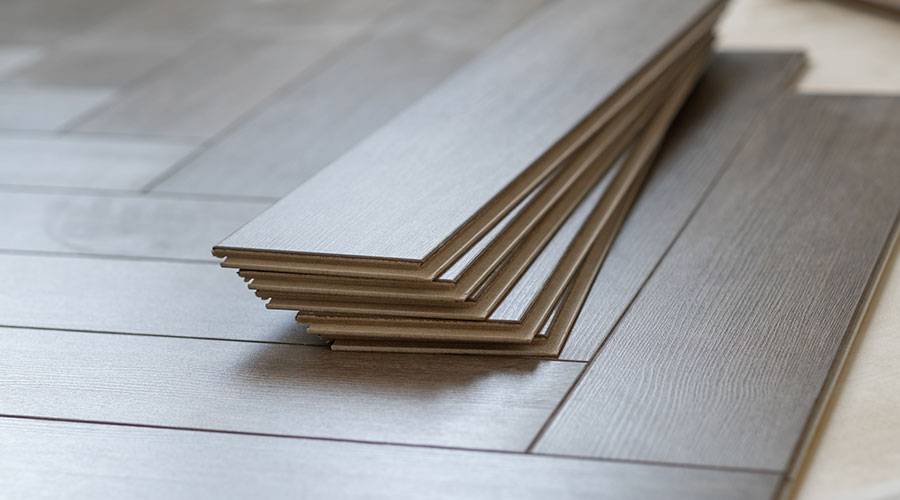Clearing the Air on Roof Warranties
Overlooked and misunderstood, warranties can provide an added layer of protection — if managers get the facts right
More than anyone else in facilities, maintenance and engineering managers understand the importance of roofing systems. Their departments receive the first call if a leak develops, their staffs inspect and maintain the systems, and they are key players when organizations must decide whether to repair or replace a roofing system.
So why, roofing systems manufacturers wonder, do so few managers — and even fewer owners — seem to understand the warranties that dictate everything to do with installing, inspecting, repairing, and replacing this most vital building component?
“About 99.9 percent do not read their warranties,” says Rick Tucker, North America marketing manager with Honeywell’s specialty materials business unit. “They don’t know if it covers materials, materials and labor, or is a no-dollar-limit warranty.”
This lack of awareness among managers is puzzling for many reasons, but especially because their specification processes generally demand a warranty.
“Many owners require a warranty, but they never look to see what’s covered,” Tucker says.
As a result, myths, misconceptions and misunderstandings abound when it comes to specifying, installing, repairing and replacing roofing systems.
“Most misunderstandings with warranties stem from a lack of an owner’s or contractor’s actual knowledge of the content of a warranty itself,” says David Schick, warranty program administrator with Mule-Hide Products.
A Closer Look
Perhaps the biggest misconception surrounding warranties involves the very nature of the document. Managers too often believe a warranty covers certain materials and activities when, in fact, it does not.
“Generally, warranties are not replacement guarantees,” Schick says. “Rather, they might provide coverage for labor and material costs for the repair of leaks in a roof system based on the individual manufacturer’s definition of the system spelled out in its warranty form.
“Warranties are not intended to be commercial insurance policies in the conventional sense,” he says. “If they were, the costs of warranties would be significantly higher.”
Manufacturers of roofing materials generally issue the warranties. In some cases, such as with lower-cost installations, the roofing contractor provides a warranty for workmanship and a materials-only warranty from the manufacturer.
Warranties fall into two general categories: implied and express.
“Implied warranties are created by state law and are neither spoken nor written promises about the condition of a product when sold,” says Ken Crocker, technical manager with GenFlex Roofing Systems. “Express warranties in most cases explicitly define what the warranty covers and what the warranty excludes from coverage. In many cases, an express warranty will also define the resolution process should a claim be made.”
The difference between the two types is important for managers to understand.
“The difference between express warranty and implied warranty is that implied warranty does not offer any specifics about the goods,” Schick says. “An express warranty can exist if, for example, samples were provided during the submittal stage of a project, in which case the seller is warranting that the product to be used in the roof is equal in quality to that of the sample. Even language used in a project proposal can be used to form the basis of an express warranty.”
Many warranties contain a list of exclusions that can be lengthy — hurricanes, gale-force winds and high wind gusts, ponding water, and additions or alterations to the roof unless the manufacturer is notified in advance and approves the alteration or addition in writing.
“Many warranties exclude coverage for the costs of repairs to damage to a system, but notification to the warranting manufacturer is important, as failing to use reasonable care in maintaining a roof by the owner might result in voiding coverage under a warranty,” Schick says.
Inspect, Repair, Replace
Problems with roofs are inevitable, but managers too often worry about weather-related problems instead of a common cause much closer to home.
“The harshest factor is not the elements,” says Steve Ruth, vice president of sales and marketing with Duro-Last Roofing. “Humans will do more damage to a roof that Mother Nature ever will.”
From heavy foot traffic to dropped tools or equipment, roof damage from humans is frequent.
When repairs are required, warranties very clearly spell out the actions managers can and cannot take in inspecting roofs, fixing leaks and making other changes. Paying close attention to these requirements can help avoid misunderstandings, not to mention major costs and headaches.
The requirements for activities such as inspection and documentation “are fairly stringent on the owner,” Tucker says. Yet managers routinely overlook them.
Take the inspection process, which many organizations handle casually, rather than formally.
“The contractor may offer a yearly maintenance program to inspect the roof to prevent small problems from becoming large,” says Anita Whittington, risk manager for Conklin Co. Inc. “Our warranty program requires the yearly inspection to maintain the warranty,” emphasizing the word requires.
Carrying out repairs involves much more than the actual fix.
“Most warranties in the industry require that covered repairs be completed by a contractor assigned and authorized by the manufacturer holding the warranty after proper notification by the building owner,” Schick says.
Managers also need to pay close attention to the provisions for roof replacement.
“Most often repairs are performed without resorting to full roof replacement,” Crocker says. “If, however, a roof replacement is determined to be the best solution to a warranted problem by the warranty underwriter, then in most cases the warranty would cover labor and material costs associated with replacement of the warranted material in the roof system.”
“In warranty cases involving roof replacement, some property owners are actually surprised to find out their roof was assembled with non-warranted products that were purchased as a commodity item by the roofing contractor for use in their roof system,” he says.
Among the items from other manufacturers managers typically can use in warranted roof systems include insulation and insulation fasteners on non-adhered systems, penetration flashings and sealants, and metalwork, Crocker says.
Negating a Warranty
Among the biggest mistakes managers make that can cause problems with a warranty involves making repairs improperly. But warranties also can present a host of other potential pitfalls.
“There are a lot of clauses in the warranty that can void the warranty,” Tucker says, and managers stumble into them regularly. “Manufacturers often are looking for any reason to find a warranty invalid.”
Managers generally have some leeway under most warranties.
“Each manufacturer provides owners of warranted roofs a list of recommended inspection intervals and maintenance items that must be recognized,” Crocker says. “These items are intended to help the property owner protect his long-term roof investment. Generally speaking, failure to follow these instructions in and of itself will not void a warranty.”
That hardly means managers do not need to pay attention to them.
“Failure to perform the recommended inspections and maintenance can create a situation where a claim can be contested by the manufacturer if the cause of the claim is something that could reasonably have been identified prior to failure by the recommended action, had it been taken,” Crocker says.
He cites several actions managers and their staffs take that risk negating the roof-system warranty:
Roof alterations. “This is a big one, and it occurs mostly during tenant fit-up on new construction projects,” Crocker says. “Some landlords allow their tenants to hire their own roofers to perform fit-ups. All alterations to the roof system should be performed by a qualified installer of the specific manufacturer’s material. And the alterations must be coordinated with the manufacturer prior to commencing work.”
Negligence. Examples of negligence include not maintaining the roof system or allowing access to the roof by the public and or allowing its use as a smoking or break area. Managers should restrict roof access to those with a legitimate purpose and maintain an access log for recordkeeping purposes.
Improper design. “This includes design factors that negatively affect the performance of the roof system,” Crocker says, citing corrosive environments unsuitable for the given roof system, excessive internal building pressure, improper building components, and problems created by a roof system from an existing roof left in place in re-cover situations.
Words of Advice
Manufacturers have seen it all when it comes to warranties, and they offer guidance in helping managers get the most out of their provisions for protection.
First and foremost, get the warranty early, and read it.
“Managers should require that a sample of the warranty offered is given with the bid so that all parties understand the terms,” Whittington says. “Many roofing contractors simply state that a warranty will be given upon completion in the proposal and then no warranty document is ever actually produced.”
Next, understand the warranty’s language describing the claim-resolution process.
“Most warranties are very specific about where the litigation or arbitration would take place,” Tucker says, and it is not necessarily the state in which the customer’s facility is located. In fact, the site can be the sole determination of the manufacturer.
Also, check out the roofing contractor, who also might be providing a warranty. Tucker advises running a credit check on the company.
“In some cases, you have contractors issuing warranties that are in bankruptcy,” he says.
Also, as the nature of rooftops changes with the arrival of vegetative roofs and rooftop solar photovoltaic systems, discuss these systems with the manufacturer of the roofing systems.
“As the trend grows, managers need to make sure they have some type of stipulation in the warranty about these overburden systems,” Ruth says.
Finally, look beyond the number of years the warranty covers.
“There are a variety of roof systems out there, but longer (more years) doesn’t necessarily mean better,” Ruth says. “Everyone pays attention to the number at the top, but the numbers below the top number indicate that limitations are starting to come into play. You have more exclusions as you go up in years.”
This keen attention to detail can save organizations money and ensure the long-term effectiveness of the roofing system. As managers know, a reliable roof can create energy-efficiency benefits and improve occupant comfort.
“Of all the parts of a building envelope, the roof is the most important, but also the most ignored,” Sitter says.
He could just as easily been describing the prevailing attitude about roofing system warranties.
What a Warranty Isn’t
Most managers have their own ideas about what, exactly, a warranty is. But it often is just as important to understand what a warranty isn’t.
Ken Crocker, technical manager with GenFlex Roofing Systems, offers these clarifications:
•A warranty is not a commitment to perform routine roof inspections at the owner’s request.
•A roof warranty is not a substitute for proper roof care.
•A warranty does not arbitrarily cover everything in the roof system. It does not cover components from others.
•A warranty does not promise the roof will be leak-free over its service life.
•A warranty does not cover damage to the interior of the building or property, referred to as consequential damage.
— Dan Hounsell
|
Related Topics:











